Utilization of Earth-to-Air Heat Exchanger to Pre-Cool/Heat Ventilation Air and Its Annual Energy Performance Evaluation: A Case Study
Abstract
:1. Introduction
2. Description of the EAHE-Assisted Building Ventilation System
3. Methodology
3.1. Mathematical Model of Underground Soil Temperature
3.2. Mathematical Model of the EAHE
3.3. Evaluation Indexes
4. Simulation Conditions
5. Annual Performance Evaluation and Discussion
5.1. Evaluation of Underground Soil Temperature
5.2. Influence of Design Parameters on the Thermal Performance of the EAHE
5.3. Energy-Saving Potential of EAHE-Assisted Building Ventilation
5.4. Opportunities of the EAHE System for Net-Zero Energy Buildings
6. Conclusions
Author Contributions
Funding
Conflicts of Interest
Nomenclature
| As | amplitude of annual soil surface temperature, K |
| Ca | specific heat capacity of air, kJ/(kgK) |
| d | humidity ratio, g/kg |
| e | thickness of pipe wall, m |
| EAHE | earth-to-air heat exchanger |
| f | friction coefficient of pipe |
| h | convective heat transfer coefficient, W/(m2K) |
| ka | thermal conductivities of air, W/(mK) |
| kp | thermal conductivities of pipe, W/(mK) |
| ks | thermal conductivities of soil, W/(mK) |
| L | length of buried pipe, m |
| La | latent heat vaporization of water, kJ/kg |
| ma | mass flow rate of ventilation air, kg/h |
| Nc | cumulative hours for cooling season |
| Nh | cumulative hours for heating season |
| Qcool | average daily cooling capacity, kWh |
| Qheat | average daily heating capacity, kWh |
| QEAHE | energy demand for conditioning the ventilation air with EAHE, kWh |
| Qvent | energy demand for conditioning the ventilation air, kWh |
| ri | inner radius of pipe, m |
| rs | radius of undisturbed soil surface, m |
| Rconv | convective thermal resistance between flowing air and pipe wall, (mK)/W |
| Rpipe | conductive thermal resistance of pipe wall, (mK)/W |
| Rsoil | conductive thermal resistance, (mK)/W |
| Rtotal | total thermal resistance of EAHE, (mK)/W |
| to | time of annual minimum soil surface temperature |
| Tamb | ambient air temperature, K |
| Tcool | precooling performance of EAHE, K |
| Theat | preheating performance of EAHE, K |
| Ti | indoor temperature, K |
| Toutlet | outlet air temperature of EAHE, K |
| Ts | underground soil temperature, K |
| Ts,mean | mean annual temperature of soil surface, K |
| z | depth, m |
| αs | thermal diffusivity of soil, m2/h |
| η | energy-saving potential of EAHE system for building ventilation |
References
- Tsinghua University Building Energy Research Center. Annual Report on China Building Energy Efficiency; China Architecture & Building Press: Beijing, China, 2019. [Google Scholar]
- International Energy Agency (IEA). World Energy Statistics and Balances; OECD/IEA: Paris, France, 2018. [Google Scholar]
- Ahmed, W.; Asif, M.; Alrashed, F. Application of building performance simulation to design energy-efficient homes: Case study from Saudi Arabia. Sustainability 2019, 11, 6048. [Google Scholar] [CrossRef] [Green Version]
- Shahsavar, A.; Khanmohammadi, S. Feasibility of a hybrid BIPV/T and thermal wheel system for exhaust air heat recovery: Energy and exergy assessment and multi-objective optimization. Appl. Eng. 2019, 146, 104–122. [Google Scholar] [CrossRef]
- Zhang, C.; Gang, W.J.; Wang, J.B.; Xu, X.H.; Du, Q.Z. Numerical and experimental study on the thermal performance improvement of a triple glazed window by utilizing low-grade exhaust air. Energy 2019, 167, 1132–1143. [Google Scholar] [CrossRef]
- Wang, J.B.; Du, Q.Z.; Zhang, C.; Xu, X.H.; Gang, W.J. Mechanism and preliminary performance analysis of exhaust air insulation for building envelope wall. Energy Build. 2018, 173, 516–529. [Google Scholar] [CrossRef]
- Fan, C.; Wang, J.; Gang, W.J.; Li, S. Assessment of deep recurrent neural network-based strategies for short-term building energy predictions. Appl. Energy 2019, 236, 700–710. [Google Scholar] [CrossRef]
- Zhang, C.; Cui, C.L.; Zhang, Y.; Yuan, J.Q.; Luo, Y.M.; Gang, W.J. A review of renewable energy assessment methods in green building and green neighborhood rating systems. Energy Build. 2019, 195, 68–81. [Google Scholar] [CrossRef]
- Tejero-González, A.; Esquivias, P.M. Personalized evaporative cooler to reduce energy consumption and improve thermal comfort in free-running spaces. Sustainability 2019, 11, 6451. [Google Scholar] [CrossRef] [Green Version]
- Yuan, J.Q.; Cui, C.L.; Xiao, Z.W.; Zhang, C.; Gang, W.J. Performance analysis of thermal energy storage in distributed energy system under different load profiles. Energy Convers. Manag. 2020, 208, 112596. [Google Scholar] [CrossRef]
- Wiriyasart, S.; Naphon, P. Numerical study on air ventilation in the workshop room with multiple heat sources. Case Stud. Eng. 2019, 13, 100405. [Google Scholar] [CrossRef]
- Ribé, O.; Ruiz, R.; Quera, M.; Cadafalch, J. Analysis of the sensible and total ventilation energy recovery potential in different climate conditions. Application to the Spanish case. Appl. Eng. 2019, 149, 854–861. [Google Scholar] [CrossRef]
- Albdoor, A.K.; Ma, Z.J.; Cooper, P.; Ren, H.; Al-Ghazzawi, F. Thermodynamic analysis and design optimisation of a cross flow air to air membrane enthalpy exchanger. Energy 2020, 202, 117691. [Google Scholar] [CrossRef]
- Wang, L.; Xiao, F.; Niu, X.F.; Gao, D.C. A dynamic dehumidifier model for simulations and control of liquid desiccant hybrid air conditioning systems. Energy Build. 2017, 140, 418–429. [Google Scholar] [CrossRef]
- Gurubalan, A.; Maiya, M.P.; Geoghegan, P.J. A comprehensive review of liquid desiccant air conditioning system. Appl. Energy 2019, 254, 113673. [Google Scholar] [CrossRef]
- Alongi, A.; Angelotti, A.; Mazzarella, L. Experimental validation of a steady periodic analytical model for breathing walls. Build. Environ. 2020, 168, 106509. [Google Scholar] [CrossRef] [Green Version]
- Michaux, G.; Greffet, R.; Salagnac, P.; Ridoret, J.B. Modelling of an airflow window and numerical investigation of its thermal performances by comparison to conventional double and triple-glazed windows. Appl. Energy 2019, 242, 27–45. [Google Scholar] [CrossRef]
- Tewari, P.; Mathur, S.; Mathur, J.; Kumar, S.; Loftness, V. Field study on indoor thermal comfort of office buildings using evaporative cooling in the composite climate of India. Energy Build. 2019, 199, 145–163. [Google Scholar] [CrossRef]
- Shahsavar, A.; Rajabi, Y. Exergoeconomic and enviroeconomic study of an air based building integrated photovoltaic/thermal (BIPV/T) system. Energy 2018, 144, 877–886. [Google Scholar] [CrossRef]
- Fazlikhani, F.; Goudarzi, H.; Solgi, E. Numerical analysis of the efficiency of earth to air heat exchange systems in cold and hot-arid climates. Energy Convers. Manag. 2017, 148, 78–89. [Google Scholar] [CrossRef]
- Rosti, B.; Omidvar, A.; Monghasemi, N. Optimum position and distribution of insulation layers for exterior walls of a building conditioned by earth-air heat exchanger. Appl. Eng. 2019, 163, 114362. [Google Scholar] [CrossRef]
- Maoz, A.S.; Muhammad, N.; Amin, A.; Sohaib, M.; Basit, A.; Ahmad, T. Parametric optimization of earth to air heat exchanger using response surface method. Sustainability 2019, 11, 3186. [Google Scholar] [CrossRef] [Green Version]
- Lee, K.H.; Strand, R.K. The cooling and heating potential of an earth tube system in buildings. Energy Build. 2008, 40, 486–494. [Google Scholar] [CrossRef]
- Ascione, F.; Bellia, L.; Minichiello, F. Earth-to-air heat exchangers for Italian climates. Renew. Energy 2011, 36, 2177–2188. [Google Scholar] [CrossRef]
- Amanowicz, Ł.; Wojtkowiak, J. Approximated flow characteristics of multi-pipe earth-to-air heat exchangers for thermal analysis under variable airflow conditions. Renew. Energy 2020, 158, 585–597. [Google Scholar] [CrossRef]
- Minaei, A.; Safikhani, H. A new transient analytical model for heat transfer of earth-to-air heat exchangers. J. Build. Eng. 2020, 33, 101560. [Google Scholar] [CrossRef]
- Gomat, L.J.P.; Motoula, S.M.E.; M’Passi-Mabiala, B. An analytical method to evaluate the impact of vertical part of an earth-air heat exchanger on the whole system. Renew. Energy 2020, 162, 1005–1016. [Google Scholar] [CrossRef]
- Al-Ajmi, F.; Loveday, D.L.; Hanby, V.I. The cooling potential of earth-air heat exchanger for domestic buildings in a desert climate. Build. Environ. 2006, 41, 235–244. [Google Scholar] [CrossRef]
- Belatrache, D.; Bentouba, S.; Bourouis, M. Numerical analysis of earth air heat exchangers at operating conditions in arid climates. Int. J. Hydrog. Energy 2017, 42, 8898–8904. [Google Scholar] [CrossRef]
- Wei, H.B.; Yang, D.; Wang, J.; Du, J.H. Field experiments on the cooling capability of earth-to-air heat exchangers in hot and humid climate. Appl. Energy 2020, 276, 115493. [Google Scholar] [CrossRef]
- Li, H.; Ni, L.; Liu, G.; Yao, Y. Performance evaluation of Earth to Air Heat Exchange (EAHE) used for indoor ventilation during winter in severe cold regions. Appl. Eng. 2019, 160, 114111. [Google Scholar] [CrossRef]
- Li, H.; Ni, L.; Yao, Y.; Sun, C. Experimental investigation on the cooling performance of an Earth to Air Heat Exchanger (EAHE) equipped with an irrigation system to adjust soil moisture. Energy Build. 2019, 196, 280–292. [Google Scholar] [CrossRef]
- Li, H.; Ni, L.; Liu, G.; Zhao, Z.; Yao, Y. Feasibility study on applications of an Earth-air Heat Exchanger (EAHE) for preheating fresh air in severe cold regions. Renew. Energy 2019, 133, 1268–1284. [Google Scholar] [CrossRef]
- Kumar, R.; Ramesh, S.; Kaushik, S.C. Performance evaluation and energy conservation potential of earth–air–tunnel system coupled with non-air-conditioned building. Build. Environ. 2003, 38, 807–813. [Google Scholar] [CrossRef]
- Xamán, J.; Hernández-López, I.; Alvarado-Juárez, R.; Hernández-Pérez, I.; Álvarez, G.; Chávez, Y. Pseudo transient numerical study of an earth-to-air heat exchanger for different climates of México. Energy Build. 2015, 99, 273–283. [Google Scholar] [CrossRef]
- Liu, Z.; Yu, Z.J.; Yang, T.; Roccamena, L.; Sun, P.; Li, S.; Zhang., G.; El Mankibi, M. Numerical modeling and parametric study of a vertical earth-to-air heat exchanger system. Energy 2019, 172, 220–231. [Google Scholar] [CrossRef]
- Ghosal, M.K.; Tiwari, G.N. Modeling and parametric studies for thermal performance of an earth to air heat exchanger integrated with a greenhouse. Energy Convers. Manag. 2006, 47, 1779–1798. [Google Scholar] [CrossRef]
- Al-Ajmi, F.; Hanby, V.I.; Loveday, D.L. Thermal performance of the subsoil environment in a dry desert climate. ASHRAE Trans. 2002, 108, 395–405. [Google Scholar]
- Derbel, H.B.J.; Kanoun, O. Investigation of the ground thermal potential in Tunisia focused towards heating and cooling applications. Appl. Eng. 2010, 30, 1091–1100. [Google Scholar]
- Maerefat, M.; Haghighi, A.P. Passive cooling of buildings by using integrated earth to air heat exchanger and solar chimney. Renew. Energy 2010, 35, 2316–2324. [Google Scholar] [CrossRef]
- Bansal, V.; Mishra, R.; Agarwal, G.D.; Mathur, J. Performance analysis of integrated earth–air-tunnel-evaporative cooling system in hot and dry climate. Energy Build. 2012, 47, 525–532. [Google Scholar] [CrossRef]
- Gnielinski, V. New equation for heat and mass transfer in turbulent pipe and channel flow. Int. Chem. Eng. 1976, 16, 359–368. [Google Scholar]
- Zhong, K.; Kang, Y. Applicability of air-to-air heat recovery ventilators in China. Appl. Eng. 2009, 29, 830–840. [Google Scholar] [CrossRef]
- ASHARE. Standard. In Ventilation for Acceptable Indoor Air Quality; American Society of Heating, Refrigerating and Air Conditioning Engineering, Inc.: Atlanta, GA, USA, 2013. [Google Scholar]
- Ministry Housing and Urban-Rural Development of People’s Republic of China. Design Standard for Energy Efficiency of Residential Buildings in Hot Summer and Cold Winter Zone (JGJ134-2010); Architecture & Building Press: Beijing, China, 2010.
- Sudhakar, K.; Winderl, M.; Priya, S.S. Net-zero building designs in hot and humid climates: A state-of-art. Case Stud. Eng. 2019, 13, 100400. [Google Scholar] [CrossRef]
- Piderit, M.B.; Vivanco, F.; van Moeseke, G.; Attia, S. Net Zero Buildings—A Framework for an Integrated Policy in Chile. Sustainability 2019, 11, 1494. [Google Scholar] [CrossRef] [Green Version]
- Piasecki, M.; Fedorczak-Cisak, M.; Furtak, M.; Biskupski, J. Experimental confirmation of the reliability of fanger’s thermal comfort model—Case study of a near-zero energy building (NZEB) office building. Sustainability 2019, 11, 2461. [Google Scholar] [CrossRef] [Green Version]
- Ascione, F.; D’Agostino, D.; Marino, C.; Minichiello, F. Earth-to-air heat exchanger for NZEB in Mediterranean climate. Renew. Energy 2016, 99, 553–563. [Google Scholar] [CrossRef]
- Sajjad, U.; Amer, M.; Ali, H.M.; Dahiya, A.; Abbas, N. Cost effective cooling of photovoltaic modules to improve efficiency. Case Stud. Eng. 2019, 14, 100420. [Google Scholar] [CrossRef]
- Zhang, C.; Gang, W.J.; Xu, X.H.; Li, L.; Wang, J.B. Modelling, experimental test, and design of an active air permeable wall by utilizing the low-grade exhaust air. Appl. Energy 2019, 240, 730–743. [Google Scholar] [CrossRef]
- Zhang, C.; Gang, W.J.; Wang, J.B.; Xu, X.H.; Du, Q.Z. Experimental investigation and dynamic modeling of a triple-glazed exhaust air window with built-in venetian blinds in the cooling season. Appl. Eng. 2018, 140, 73–85. [Google Scholar] [CrossRef]
- Zhang, C.; Wang, J.B.; Li, L.; Gang, W.J. Dynamic thermal performance and parametric analysis of a heat recovery building envelope based on air-permeable porous materials. Energy 2019, 189, 116361. [Google Scholar] [CrossRef]
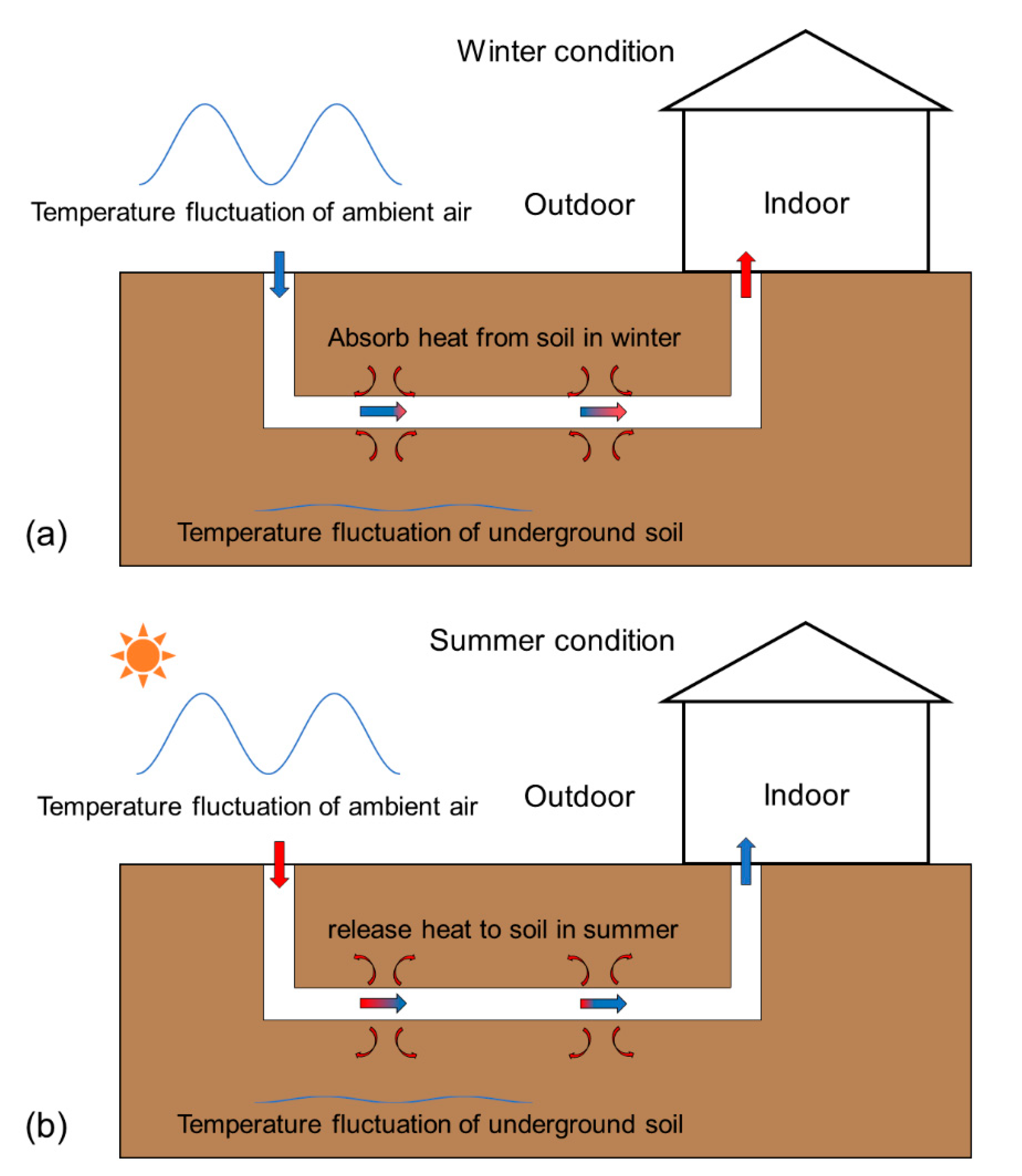
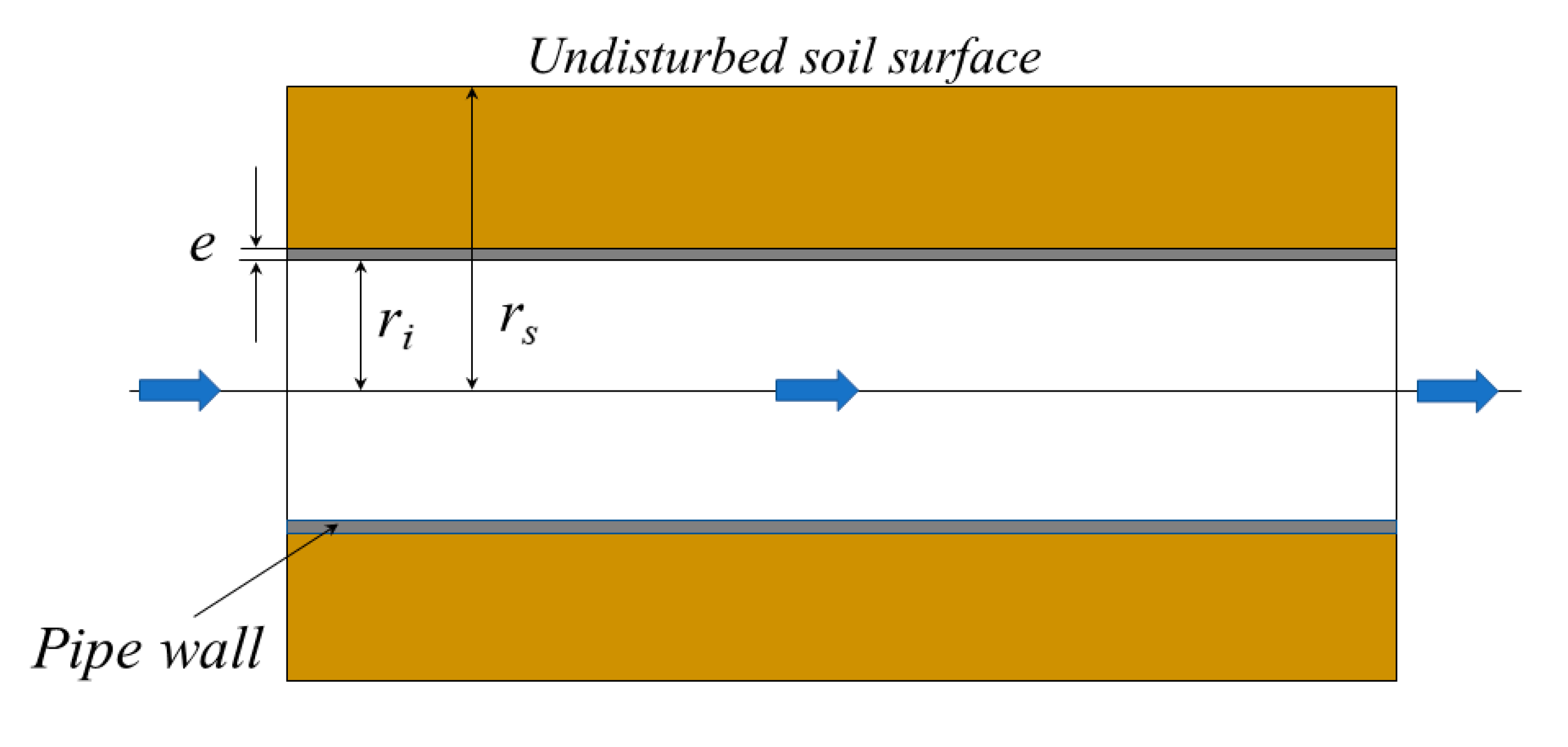
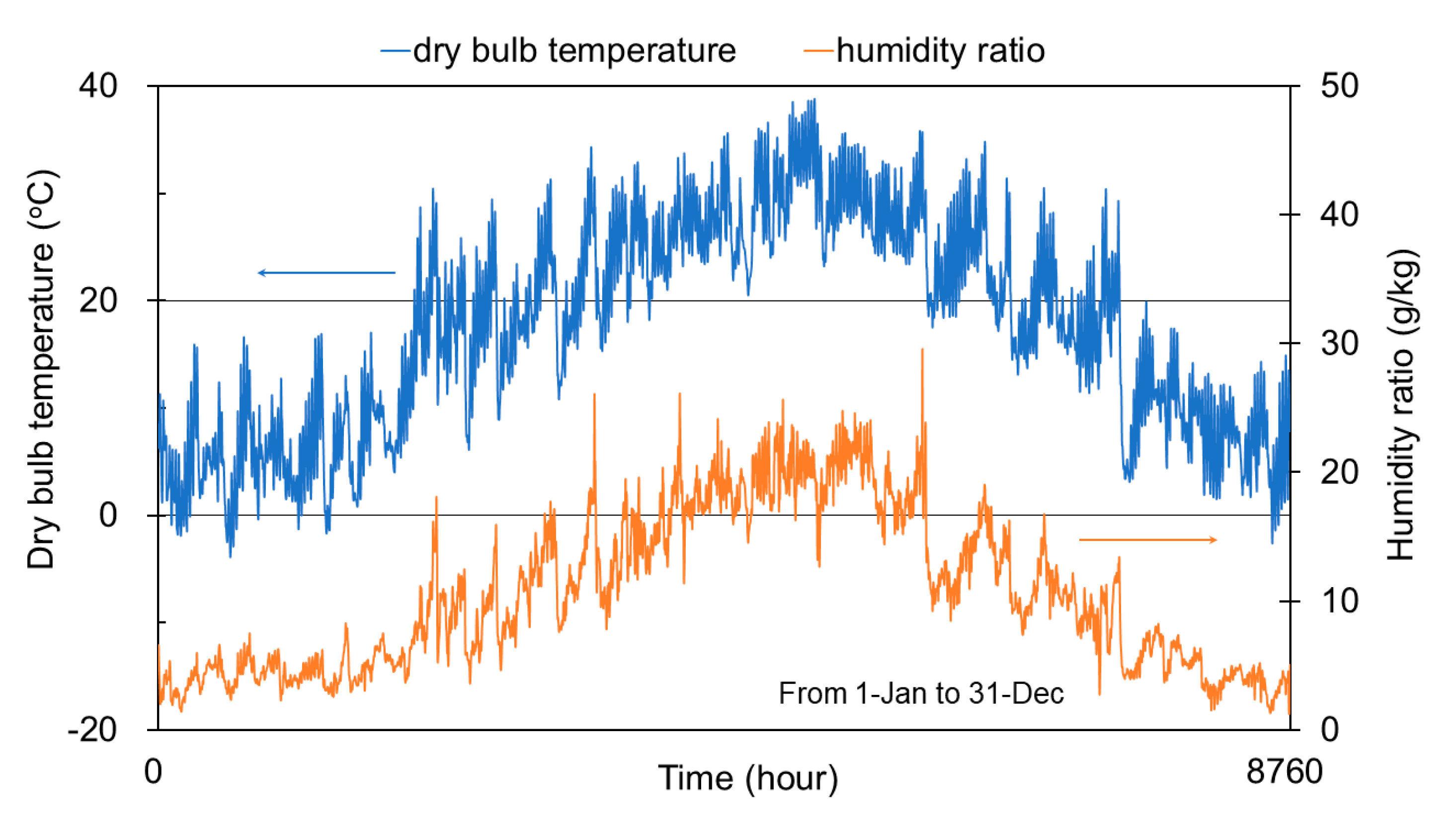

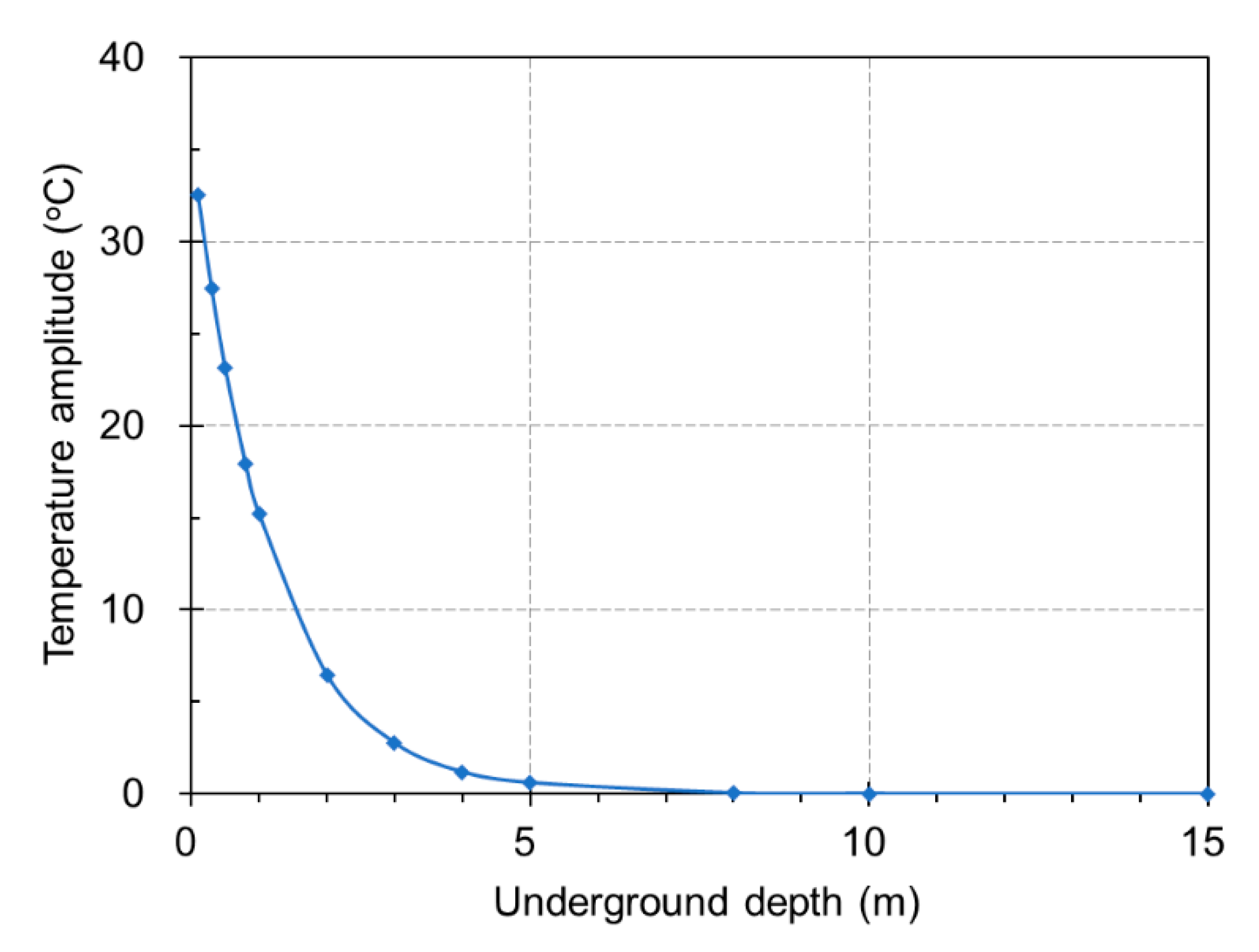
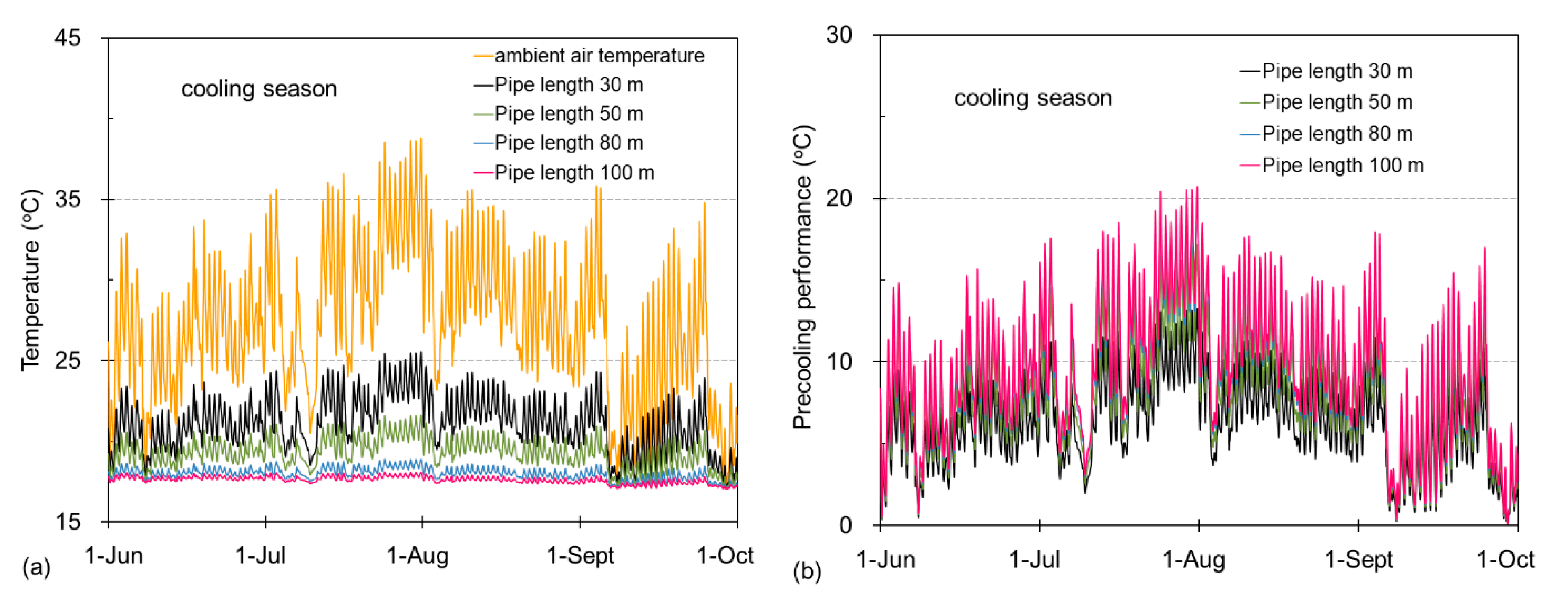

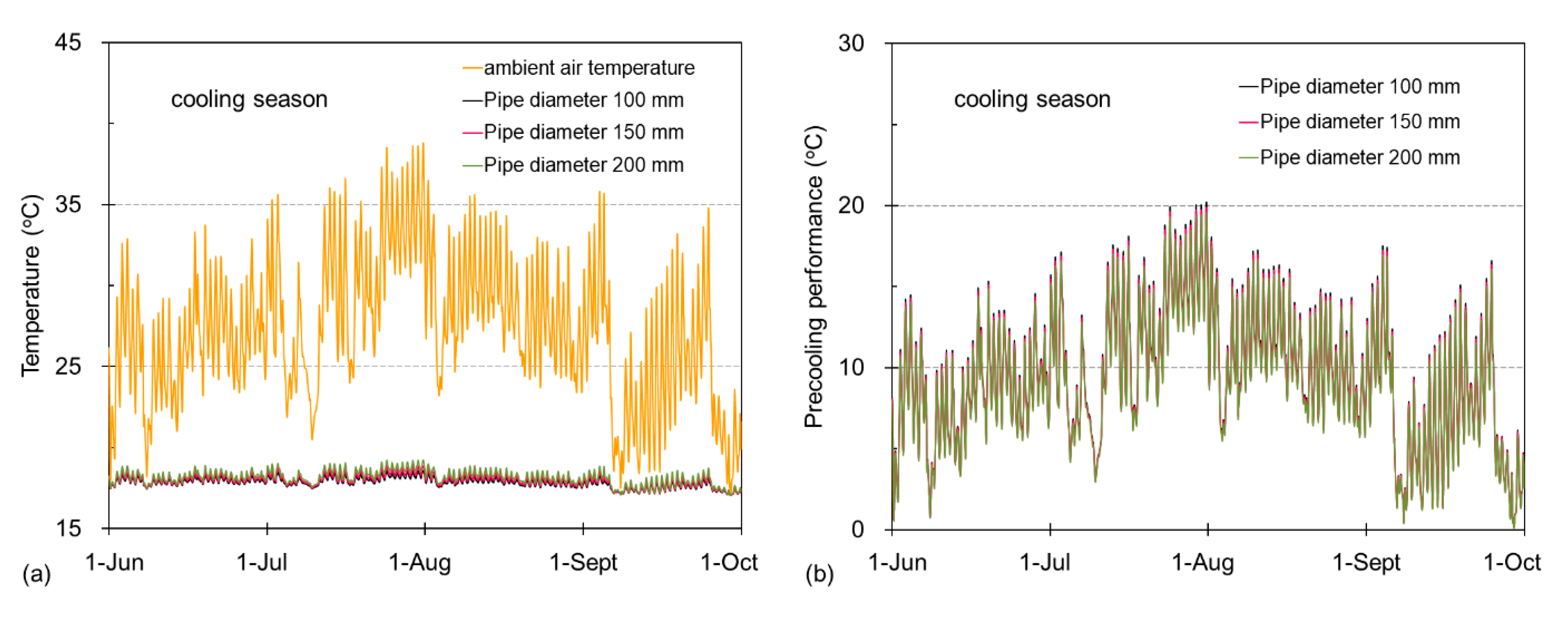



| Parameter | Value | Unit |
|---|---|---|
| Pipe depth | 0.1–15 | m |
| Pipe length | 30–100 | m |
| Pipe internal diameter | 100–200 | mm |
| Thickness of pipe wall | 2 | mm |
| Thermal conductivity of pipe | 0.16 | W/(mK) |
| Ventilation rate | 243 | m3/h |
| Density of air | 1.205 | kg/m3 |
| Specific heat capacity of air | 1013 | J/(kgK) |
| Thermal conductivity of air | 0.02593 | W/(mK) |
| Kinematic viscosity of air | 15.06 × 10−6 | m2/s |
| Pr | 0.703 | - |
| Density of soil | 2050 | kg/m3 |
| Specific heat capacity of soil | 1840 | J/(kgK) |
| Thermal conductivity of soil | 0.52 | W/(mK) |
| Thermal diffusivity of soil | 0.0004963 | m2/h |
| Evaluation Index | 30 m | 50 m | 80 m | 100 m |
|---|---|---|---|---|
| Average precooling performance (°C) | 6.2 | 8.0 | 9.3 | 9.6 |
| Daily cooling capacity (kWh) | 12.4 | 16.1 | 18.6 | 19.4 |
| Average preheating performance (°C) | 7.3 | 9.4 | 10.9 | 11.3 |
| Daily heating capacity (kWh) | 14.6 | 18.9 | 21.9 | 22.8 |
| Evaluation Index | 100 mm | 150 mm | 200 mm |
|---|---|---|---|
| Average precooling performance (°C) | 9.4 | 9.3 | 9.1 |
| Daily cooling capacity (kWh) | 20.2 | 19.9 | 19.6 |
| Average preheating performance (°C) | 11.0 | 10.9 | 10.7 |
| Daily heating capacity (kWh) | 19.9 | 19.6 | 19.3 |
| Accumulated Energy Demand | Ventilation without EAHE System | EAHE-System-Assisted Ventilation | Relative Energy Reduction of EAHE |
|---|---|---|---|
| Energy demand for cooling (kWh) | 4711.8 | 3957.2 | 16.0% |
| Energy demand for heating (kWh) | 3993.5 | 1992.9 | 50.1% |
© 2020 by the authors. Licensee MDPI, Basel, Switzerland. This article is an open access article distributed under the terms and conditions of the Creative Commons Attribution (CC BY) license (http://creativecommons.org/licenses/by/4.0/).
Share and Cite
Zhang, C.; Wang, J.; Li, L.; Wang, F.; Gang, W. Utilization of Earth-to-Air Heat Exchanger to Pre-Cool/Heat Ventilation Air and Its Annual Energy Performance Evaluation: A Case Study. Sustainability 2020, 12, 8330. https://doi.org/10.3390/su12208330
Zhang C, Wang J, Li L, Wang F, Gang W. Utilization of Earth-to-Air Heat Exchanger to Pre-Cool/Heat Ventilation Air and Its Annual Energy Performance Evaluation: A Case Study. Sustainability. 2020; 12(20):8330. https://doi.org/10.3390/su12208330
Chicago/Turabian StyleZhang, Chong, Jinbo Wang, Liao Li, Feifei Wang, and Wenjie Gang. 2020. "Utilization of Earth-to-Air Heat Exchanger to Pre-Cool/Heat Ventilation Air and Its Annual Energy Performance Evaluation: A Case Study" Sustainability 12, no. 20: 8330. https://doi.org/10.3390/su12208330
APA StyleZhang, C., Wang, J., Li, L., Wang, F., & Gang, W. (2020). Utilization of Earth-to-Air Heat Exchanger to Pre-Cool/Heat Ventilation Air and Its Annual Energy Performance Evaluation: A Case Study. Sustainability, 12(20), 8330. https://doi.org/10.3390/su12208330






